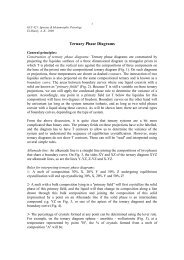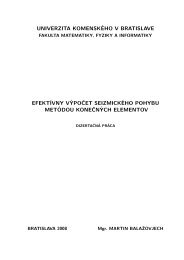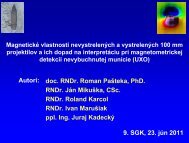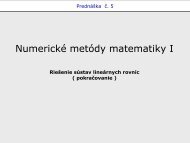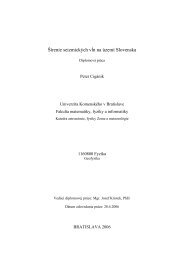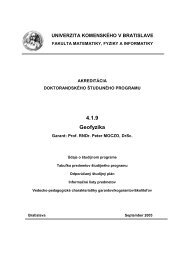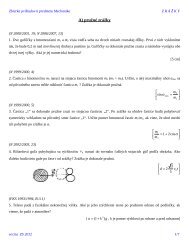Prutkin, Vajda, Tenzer, Bielik 3D inversion of gravity data by ...
Prutkin, Vajda, Tenzer, Bielik 3D inversion of gravity data by ...
Prutkin, Vajda, Tenzer, Bielik 3D inversion of gravity data by ...
You also want an ePaper? Increase the reach of your titles
YUMPU automatically turns print PDFs into web optimized ePapers that Google loves.
<strong>3D</strong> <strong>inversion</strong> <strong>of</strong> <strong>gravity</strong> <strong>data</strong><br />
<strong>by</strong> separation <strong>of</strong> sources and the<br />
method <strong>of</strong> local corrections:<br />
Kolárovo case study<br />
<strong>Prutkin</strong> I. 1 , P. <strong>Vajda</strong> 2 , V. Bezák 2 ,<br />
R. <strong>Tenzer</strong> 3 , and M. <strong>Bielik</strong> 2,4<br />
1) Institute <strong>of</strong> Earth Sciences, Jena University, Jena, Germany,<br />
2) GFU SAV Bratislava,<br />
3) University <strong>of</strong> Otago, Dunedin,New Zealand<br />
4) KAEG, PriF UK Bratislava
the <strong>inversion</strong> method :<br />
method <strong>of</strong> local corrections<br />
<strong>inversion</strong> <strong>of</strong> potential field <strong>data</strong><br />
in terms <strong>of</strong><br />
isolated compact (star-convex) source bodies<br />
or<br />
density/magnetic contrast contact surfaces (interfaces)<br />
or<br />
the combination <strong>of</strong> the two
the method :<br />
1) Separation <strong>of</strong> signal <strong>of</strong> sources from a pre-selected<br />
depth interval :<br />
upward-downward-upward harmonic continuation<br />
2) Lateral signal <strong>of</strong> sources separation :<br />
<strong>3D</strong> line segment approximation<br />
3) Method <strong>of</strong> local corrections<br />
geometry <strong>of</strong> star-convex source homogenous bodies<br />
geometry <strong>of</strong> contrast interfaces (contact surfaces)<br />
combination <strong>of</strong> the two above
Elimination <strong>of</strong> signal <strong>of</strong> sources down to depth d<br />
(making the field harmonic down to depth d)<br />
1) Upward harmonic continuation to height = d (above surface)<br />
Poisson integral (planar approximation)<br />
removal <strong>of</strong> model regional field<br />
numerical integration inside <strong>data</strong> area only<br />
2) Downward harmonic continuation over 2d (to depth d)<br />
Poisson integral – integral equation<br />
continuation through sources<br />
linear ill-posed inverse problem -- regularization<br />
3) Upward harmonic continuation over d (back to surface)<br />
Poisson integral (planar approximation)<br />
numerical integration
REMOVAL OF MODEL REGIONAL FIELD<br />
Model regional field -- <strong>3D</strong> surface f (x,y)<br />
<br />
<br />
harmonic in 2D sense<br />
on the boundary <strong>of</strong><br />
the <strong>data</strong> area<br />
same values as <strong>data</strong><br />
has no extrema (maxima or minima) inside <strong>data</strong> area<br />
creates no false signal in terms <strong>of</strong> causative bodies<br />
UPWARD HARMONIC CONTINUATION – DIRECT<br />
PROBLEM<br />
DOWNWARD HARMONIC CONTINUATION –<br />
INVERSE PROBLEM<br />
h = d<br />
h = d<br />
h 1 = 2d
KOLÁROVO GRAVITY ANOMALY<br />
observed<br />
<strong>gravity</strong><br />
anomaly<br />
model<br />
regional<br />
field<br />
observed<br />
<strong>gravity</strong><br />
anomaly,<br />
signal <strong>of</strong><br />
shallow<br />
sources<br />
to 2 km<br />
removed<br />
residual<br />
<strong>gravity</strong><br />
anomaly<br />
signal <strong>of</strong><br />
sources
INVERSION BY THE METHOD OF LOCAL<br />
CORRECTIONS<br />
Assumptions:<br />
causative anomalous density distribution given <strong>by</strong>:<br />
star-convex compact homogenous body/bodies<br />
density contrast contact surface/surfaces (interfaces)<br />
combination <strong>of</strong> above<br />
Inversion:<br />
geometry is the solution (non-linear inverse problem)<br />
non-linear integral equation for <strong>3D</strong> geometry <strong>of</strong> the boundary<br />
discretization<br />
ill-posed problem – regularization<br />
iterations (for <strong>3D</strong> geometry <strong>of</strong> surfaces / body shapes)<br />
<strong>3D</strong> line segments assist in starting the iterations<br />
assymptotic plane in case <strong>of</strong> contrast interfaces
KOLÁROVO GRAVITY ANOMALY INVERSION –<br />
SOLUTION A<br />
2 line segments – bottom boundary <strong>of</strong><br />
sediments (contour lines – depth to basement)<br />
1 line segment – anomalous causative<br />
body (ellipsoid) entirely within basement<br />
top<br />
view<br />
density contrast 300 kg/m 3<br />
WE<br />
SN
KOLÁROVO GRAVITY ANOMALY INVERSION –<br />
SOLUTION B<br />
Anomalous body<br />
3 line segments – anomalous causative body<br />
intrusion <strong>of</strong> basic lower crustal material<br />
into upper crust<br />
density contrast 300 kg/m 3
KOLÁROVO GRAVITY ANOMALY INVERSION –<br />
SOLUTION C<br />
Contact surface <strong>of</strong> a density contrast (interface)<br />
density contrast 300 kg/m 3<br />
top view<br />
elevation (uplift) <strong>of</strong> basic lower<br />
crustal material
KOLÁROVO GRAVITY ANOMALY INVERSION –<br />
SOLUTION D<br />
contact surface and anomalous body<br />
intrusion <strong>of</strong><br />
basic lower crustal<br />
material<br />
into upper crust<br />
elevation (uplift)<br />
<strong>of</strong> lower crust<br />
density contrast 300 kg/m 3
KOLÁROVO GRAVITY ANOMALY INVERSION –<br />
SOLUTION E<br />
2 contact surfaces (signal 50% / 50%) – NS cross-section<br />
density contrast 300 kg/m 3<br />
density contrast 200 kg/m 3
DISCUSSION<br />
The solution is unique – in terms <strong>of</strong> geometry:<br />
for a source body<br />
<strong>of</strong> given density contrast and given weight<br />
for a contact surface<br />
<strong>of</strong> given weight, density contrast and depth <strong>of</strong> assymptotic plane<br />
The solution is non-unique (arbitrary decisions)<br />
number <strong>of</strong> bodies and/or contact surfaces<br />
weigts <strong>of</strong> bodies / contact surfaces<br />
density contrasts<br />
depths <strong>of</strong> assymptotic planes
CONCLUSIONS<br />
The „<strong>Prutkin</strong>“ <strong>inversion</strong> method<br />
<strong>of</strong>fers a great tool for potential field <strong>data</strong> interpretation<br />
produces several sets <strong>of</strong> admissible model solutions<br />
the admissible solutions can be discriminated based on<br />
geological, tectonic, and additional geophysical<br />
(geoscientific) information<br />
FUTURE WORK ON KOLÁROVO<br />
joint <strong>gravity</strong>/magnetic <strong>inversion</strong><br />
geological / tectonic / geoscientific constraints



